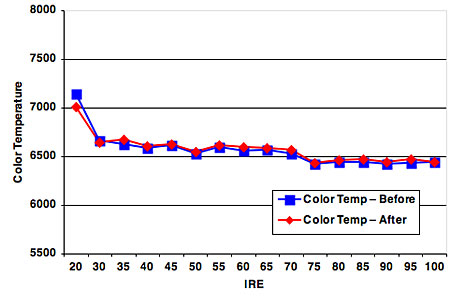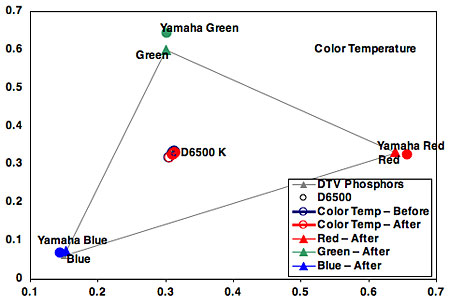Yamaha DPX-1300 DLP Projector HT Labs Measures


Full-On/Full-Off Contrast Ratio—3,400:1; ANSI Contrast Ratio—527:1
Measured Resolution with the Leader LT-446:
480: 470 (per picture height)
720p/1080i: Out to the limits of the 1,280 by 720 DMD
DC Restoration (poor, average, good, excellent): Excellent
Color Decoder (poor, average, good, excellent): Excellent
Measured Color Points:
Red Color Point: x=0.657, y=0.325
Green Color Point: x=0.302, y=0.644
Blue Color Point: x=0.144, y=0.069
The top chart shows the DPX-1300's gray scale relative to its color temperature at various levels of intensity, or brightness (20 IRE is dark gray; 100 IRE is bright white). The gray scale as set by the factory, in the 6500 color-temperature mode and the C gamma mode, measures somewhat cool with dark images and very slightly warm with brighter images. After making adjustments using the Photo Research PR-650, the gray scale measures pretty much the same, although it is slightly more accurate with a little less green in the image.
The bottom chart shows the gray scale (or color temperature) relative to the color points of the display's red, green, and blue color-filter-wheel segments. These are fairly off those specified by SMPTE. Red is oversaturated and very slightly purplish-red, while green is oversaturated and very slightly yellowish-green. Blue is very slightly oversaturated and very slightly greenish-blue. The DPX-1300 allows the user to adjust the color points. While I wouldn't recommend doing so without the right equipment, fantastic results are possible. After color-point calibration, the red and green color points are as close to accurate as we've seen (as good if not better than the nearly perfect Samsung SP-H700AE). Blue is still slightly greenish-blue but is no longer oversaturated. In the right chart, the triangles represent the color points after calibration.
After calibration (both for color temp and color points), and using a full-field 100-IRE white (6.8 foot-lamberts) and a full-field 0-IRE black (0.002 ft-L), the contrast ratio was 3,400:1. Using a 16-box checkerboard pattern (ANSI contrast), the contrast ratio was 527:1. The best contrast ratio was achieved with the iris closed and the lamp set at 80. The brightest image was achieved with the iris open and the lamp set at 100. In this mode, the DPX-1300 produced 18 ft-L with a 100-IRE field and 0.009 ft-L on a 0-IRE field (on an 87-inch-wide, 1.0-gain Da-Lite Da-Mat screen). It should be noted that, with the lamp at 100 and the iris closed, a greater light output was created with only a slight increase in black level (9.4ft-L/0.003ft-L) and with nearly the same contrast ratio (3,139:1)—GM




























































